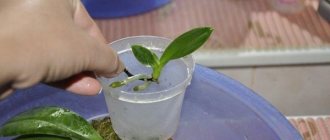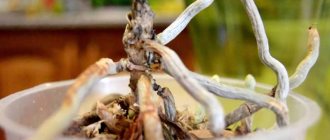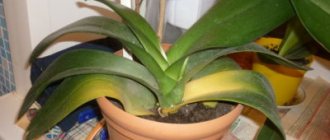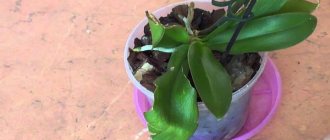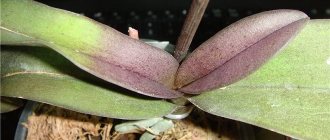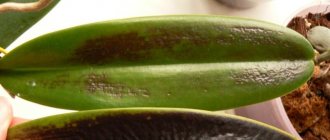Representatives of the Orchid family are fastidious, but at the same time their roots are extremely hardy. However, with regular improper care, even such a unique life support system can become unusable. The trouble, however, will not become fatal if you know how to grow roots in a phalaenopsis orchid. Reading this article will help you solve the problem of saving a flower without much difficulty.
Rules for caring for phalaenopsis
With proper and proper care, phalaenopsis will certainly delight you with its moth flowers, presented in a wide variety of shades. This type of orchid is considered unpretentious, although there are certain rules for growing the plant.
Phalaenopsis loves warmth and moderate humidity (up to 45%), does not tolerate direct sunlight, and requires a special approach to its own root system. In nature, there are phalaenopsis of epiphytic and lithophytic species, and this must be taken into account when growing orchids at home.
Such orchids thrive in diffused lighting, which can be provided through artificial lighting. The temperature regime is strict – in the range from +16ºC to +30…+31 ºC. The temperature should not drop below, this is detrimental to the plant. If it is above +31ºC, the flower will begin to actively grow leaves, but problems will arise with flowering.
The roots of phalaenopsis suffer the most from improper care, and as a result, the entire plant develops poorly and dies. Damage and rotting of the orchid root system occurs due to various reasons:
- overflow;
- low temperature;
- insufficient watering;
- poor lighting;
- poor quality substrate.
Hypothermia, overheating, desiccation of the substrate - all this also affects the condition of the flower roots. Sometimes phalaenopsis with underdeveloped roots is bought in a store, in other cases the root system begins to hurt even after home care. If measures are taken in time, the flower can be saved
How to understand that the underground part is damaged?
Death or damage to roots is detected by visual inspection. Carefully remove the flower from the pot and shake off the substrate.
It will be visible whether the flower has living roots: they will be elastic and dense, the color can be from light green to brown. Roots that have rotted from overwatering or disease will be slimy and will spread when pressed. Based on the state of the root system, resuscitation is carried out.
Reanimation of Phalaenopsis
Things are not always so dire and it happens that the phalaenopsis has several tiny roots preserved. Then it is simply transplanted into another container with mandatory fastening.
If most of the roots (up to 95-98%) are missing, you will have to try to revive the flower. In most cases, if you do everything correctly and be patient, the phalaenopsis will survive, its root system will grow back, and it will once again bloom.
Several different ways to resuscitate orchid roots are proposed, and a number of preparatory measures must be carried out:
- prepare cutting tools (with mandatory disinfection with alcohol);
- carefully clean the roots of the flower, remove all damaged and rotten parts, leaving only the living root;
- Be sure to treat all cut areas on the roots with a special powdered fungicide or crushed charcoal.
ON A NOTE!
To treat root sections, you can use regular cinnamon. If the plant has dry or slightly wilted leaves, there is no need to trim them. You can cut off the flower stalks, leaving only the lower part of the arrow.
Main causes of root loss
The orchid family is quite extensive. It contains both terrestrial and epiphytic species. Consequently, they will also differ in the types of root systems. Their roots can receive nutrition both from the air and directly from the substrate. But they all have one thing in common: they are easily damaged and die if the rules of care are not followed.
Most often, the main reasons for the loss of the root system are the following:
- non-compliance with the watering regime, flooding or over-drying can very quickly destroy even the healthiest roots;
- inappropriate temperature conditions, systematic hypothermia or overheating also do not contribute to the health of the root system;
- pests
But there are also a number of other reasons. Despite this, you should not immediately throw out the damaged plant. In most cases, its roots can be successfully grown. A variety of methods can be used for this.
Greenhouse
To revive the roots of phalaenopsis, it is necessary to create greenhouse conditions (and this is not for the sake of words, but just like that). At home, the role of a greenhouse can be played by:
- a trimmed bottle made of ordinary plastic (it is better to take large containers, 5 or 10 liters);
- aquarium.
The essence of the method is that conditions are created for the orchid in which they grow in nature: warmth, diffused lighting, optimal humidity levels. The greenhouse is placed in a well-lit place, but the hot rays of the sun are avoided.
The optimal room temperature should be around +22ºC…+28ºC. A little expanded clay is poured inside the container, sphagnum is laid and phalaenopsis is placed on top. The place where its roots grow should be in moss.
The improvised greenhouse is ventilated daily, and to keep the humidity level stable, a glass of hot water is placed inside the bottle or aquarium.
When using the “greenhouse” method, phalaenopsis can produce the first roots in about two weeks. If everything is done correctly (and the process can take from one month to a year), the orchid will give good strong roots. When their length is about 4-5 cm, the phalaenopsis can be taken out of the greenhouse and planted in a pot.
In water
Many experienced gardeners grow orchid roots in water. The options may also be different, so let’s consider everything in order.
Alternating soaking and drying
With this method, external conditions are preserved:
- the flower in the container is in a lighted place (but not in direct sunlight);
- air temperature is ensured +25…+26 ºC.
To immerse phalaenopsis in water, select a transparent container and place the plant so that the base of the roots is higher than the bottom.
Every day in the morning, pour a little water into the bottom of the container so that the roots of the plant are in it. After 6-10 hours, the water is drained, leaving the flower in this state until the next morning. In the morning the procedure is repeated again.
ON A NOTE! It is advisable to add special preparations (for example, kornevin) and fertilizers containing potassium and phosphorus needed by the plant to the water.
Also, honey, sugar, and glucose are added instead (no more than one teaspoon per liter of water).
Always in the water
Another method involves keeping the plant in water constantly, and changing the liquid every 5-6 days. This option is least suitable for orchids, since plants take a long time to grow roots, often rot, and even if they survive, they take root very poorly in substrates.
Above the water
Another way is to grow phalaenopsis roots above water. Similar to the first option, when drying and soaking is used, but in a different format. The plant is placed in a container of water, with the base of the roots above the surface of the water and not touching it. The container is closed from above.
Every day the plant is taken out (for example, in the morning), the roots are soaked in water with added sugar, then taken out, dried and placed again in a container over water.
IMPORTANT! The duration of soaking in sweet water is 60 minutes.
Upside down
A method is also used when it is not the base of the phalaenopsis roots that is immersed in water, but its leaves. To do this, you need to carefully place the plant in a container where water has already been poured. In this case, the leaves should be immersed in water only one third.
The base of the roots is exposed to air.
Every day, the upper part of the plant is irrigated with warm water from a spray bottle. In about 30-40 days, the phalaenopsis will produce the first roots.
ON A NOTE! Activated carbon must be added to the water where the leaves are immersed.
After the first roots appear at the base, the plant is placed in a transparent pot with sphagnum moss, where it will grow further. This option is convenient because not only the roots of phalaenopsis actively grow, but new leaves are preserved and even appear.
In the substrate
Very often, gardeners revive the roots of phalaenopsis not in water, but in special substrates. Many say that this option is more suitable for plants that have at least small (2-3 cm) roots. But for plants without roots, growing in a loose substrate can also be successful.
The general rules are:
- any substrate for phalaenopsis must be moist (but without excess moisture content);
- It is useful to spray orchid leaves for better growth with a special solution with vitamin B1.
Types of substrate for growing phalaenopsis roots:
- tree bark (fine fraction materials are used, which must be well steamed and dried);
- a mixture of fine expanded clay, crushed bark, sphagnum (expanded clay is used as a drainage layer);
- tightly compacted sphagnum moss.
If the plant was completely devoid of roots, then it will take a long time for regrowth - up to 10-12 months. In phalaenopsis, which have at least tiny roots, the process goes faster.
You may be interested in: How to care for orchids in a pot after purchase Why the leaves of an orchid wither and how to save it Features of the care and propagation of the Dendrobium Nobile orchid
On the bark
This method is rarely used, since the plant needs to create optimal humidity levels. In dry air, roots will not grow.
Phalaenopsis must be fixed on a piece of bark, and to stimulate growth, treat the plant with a special solution with vitamin B1. There is no need to water or even spray the flower.
The period for roots to appear is three months, but it is quite possible that there will be a longer wait.
How to grow roots in phalaenopsis
As you can see, it is not so difficult to grow roots from this orchid, which is quite common in home floriculture. The methods are quite accessible, and if you perform all the steps correctly and have patience, the flower will definitely reward you with its blooming.
To obtain a good result, it is necessary to use special preparations to stimulate root growth. All of them are sold in specialized stores, and warm, clean water is used to prepare solutions.
Ribav-Extra
Positioned as a root former, used to treat plants, and also as an anti-stress agent.
Allows you to increase productivity and germination of seed material. In the case of phalaenopsis, it stimulates root formation and promotes better plant survival.
Used for orchids: add two drops of the drug per liter of water.
Zircon
It is a universal drug that is used to stimulate plant growth and stimulate root formation. It is part of the group of phytohormones and is considered an effective supplement. The drug is based on an extract from the Echinacea purpurea plant.
Application for phalaenopsis: four drops of the drug are diluted in a liter of water.
Radifarm
A special preparation based on various plant extracts. It is a stimulator of root growth, increases the rooting of plants, and increases their survival.
For orchids, use the following composition: dilute one drop of Radifarm per liter of water.
Etamon
It belongs to a new generation of preparations, is a stimulator of root growth, and provides the plant with quickly digestible forms of nitrogen and phosphorus.
For orchids, use the following composition: take one ampoule of Etamon per liter of water.
Drugs to speed up the process
Orchid without roots - how to grow and stimulate the appearance of the first roots? Special medications will help with this.
It is worth using one of the products that will promote the appearance of the first roots. You will need to soak the base of the flower in their solution for 30 minutes before trying to grow roots on the orchid above water, or using other methods.
Among these drugs:
- Ribav-Extra (2 drops per 1 liter of water);
- Zircon (4 drops per 1 liter of water);
- Kornevin (3 g per 6 liters of water at a temperature of 25-27 degrees - the solution is made in a basin, and then a pot with an orchid is lowered into the basin);
- Radifarm (1 drop per 1 liter of water);
- Etamon (1 ampoule per 1 liter of water);
- Succinic acid (4 tablets per 1 liter of water, suitable for spraying stems and leaves);
- Glucose (dip gauze or cotton wool into the solution, and then wipe the leaves).
Fitosporin can also be used to prevent diseases. 200 drops of the product should be mixed with 200 g of water and spray the phalaenopsis with the solution twice a month.
Common mistakes
Even experienced gardeners can make mistakes, especially when caring for plants such as orchids. Despite all the unpretentiousness of phalaenopsis, certain rules must be followed, especially during such a process as growing roots.
- The orchid must be in a well-lit place. Direct sunlight is excluded, but the lighting must be sufficient. If the plant does not have enough light, it will go into long hibernation or die.
- Phalaenopsis needs certain humidity indicators, and the roots and base of the roots are not allowed to be constantly in water.
- Do not treat root sections with iodine or brilliant green solution. This can cause the roots to dry out or even burn.
- Withered and drying leaves on phalaenopsis are not cut off. While growing roots, the plant will also absorb nutrients from the leaves.
And you should never be too zealous: add more light to orchids, water the plants heavily. It is necessary to carefully study the information and only then act.
Types of children
Depending on the location, the following types of children are distinguished:
- basal;
- located on the peduncle;
- developed in the leaf axil or stem.
Most often, the development of shoots in phalaenopsis is observed on the peduncle. This may be due both to the creation of favorable conditions and to the approaching death of the mother plant. In most cases, they manage to develop into an independent plant without outside help.
The mechanism of development of root and stem children is somewhat different. It is not the dormant bud that participates in their formation, but the meristem tissue of the plant. Experienced gardeners associate the appearance of such shoots with the approaching death of the plant. Their appearance is also possible due to injuries to the trunk, death of a growing point, during a prolonged drought, or when a peduncle forms from the center of the rosette. Children that develop on the trunk or in the leaf axil may not produce roots for a long time, so their rooting is somewhat difficult.
Stem baby phalaenopsis orchid
Growing roots in water
The methods listed above for growing plants using water are the simplest. They are accessible even to novice flower growers; you just need to prepare all the necessary items in advance.
Plastic bottles, glasses, jars are used as containers for placing phalaenopsis, selecting their volume taking into account the size of the flower.
The following are used as additives in water used to grow orchid roots:
- Fitosporin;
- Kornevin;
- honey;
- sugar;
- any B vitamins.
ON A NOTE! All drugs are diluted in water, which must be settled and warm.
To improve the condition of phalaenopsis, wipe the leaves with a regular cotton pad. It is pre-moistened in an aqueous solution of succinic acid.
Preparation of the solution: dissolve one tablet of acid per glass of water.
Orchid leaves are wiped from the top and bottom sides. The solution is used for 3-4 days, then it is replaced with a new one. The procedure is carried out in the first half of the day, when the leaves are ready to completely absorb the beneficial solution.
Why is this processing needed? Succinic acid helps increase plant immunity, restore disrupted vital processes, activates root growth, and accelerates the formation of green shoots. The drug is effective even in small concentrations, and is absolutely harmless.
ON A NOTE! Succinic acid is then used in ordinary orchid care (spraying plants).
When the air temperature in the room changes (for example, when it drops), it is necessary to place the phalaenopsis in a bag (directly with the container) so that the plant is comfortable.
Orchid lighting
Phalaenopsis is not one of those orchid species that are very sensitive to light. It will be enough to follow a number of rules for the plant to develop correctly and please its owners.
- The optimal number of light hours for this type of orchid is 12. At the same time, starting in the fall and throughout the winter, the plant must be supplemented with additional light.
- Lighting should be diffused, direct sunlight (especially in the summer season) should be excluded.
- In an apartment, orchids grow best on western and northeastern windows (summer), and in winter they should be moved to southern and southwestern window sills.
- Over time, Phalaenopsis may lean slightly towards the light source. To prevent changes in the structure of the flower, it is necessary to rotate the plant very carefully (about every two to three weeks).
IMPORTANT! You cannot move the flower during budding! This may cause the buds to drop.
Do not place pots with orchids in bright light. In nature, most phalaenopsis grow surrounded by tropical trees, receiving a minimum of light. Therefore, intense illumination is only harmful to them.
Answers to pressing questions
Question No. 1. What antiseptic agents can be used to treat wounds and cuts on an orchid?
In order not to provoke infection of the plant during preparation for rooting, all cut surfaces must be disinfected. It is not recommended to use iodine, brilliant green, potassium permanganate, or alcohol for these purposes - all of these products leave deep burns on the surface of the plant . It is better to treat wounds with crushed activated carbon, ash, streptocide, cinnamon or turmeric powder. You can use fungicides, for example, "Maxim" in strict accordance with the instructions.
All instruments (scissors, pruning shears, knife, forceps, tweezers, etc.) before carrying out manipulations are treated with alcohol, peroxide, dipped in boiling water or calcined over fire.
